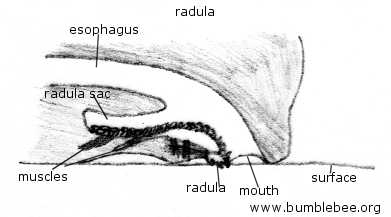
Nutrition
Fossaria parva are herbivores, meaning that they eat the vegetation that resides in their given habitat. It is not known if there are any specific plants in which the snail prefers to eat, as there is no pattern of population distribution in relationship to certain vegetation that is apparent as this time (Averbeck, 1989). Most freshwater snails, like the Fossaria parva obtain their nutrition by scraping algae off of aquatic substrates by means of their rows of teeth (which in the genus Fossaria are tricuspid) called a radula, which is located on a structure called the odontophore (Clifford, 1991). The radula and odontophore cobined is referred to as the buccal mass and acts very much like a tongue. It is projected from the mouth (located on the underside of the animal) in rhythm with the snail's movement and can occur between 24 and 60 times per minute (Dillon, 2000). After food is obtained by said structures, it is then brought into the mouth and goes through a complete digestive tract (from mouth to anus) (Clifford, 1991).
It is interesting to note at this point that gastropods have a very unique digestive tract that is developed at the early stages of life. During embryonic development, all gastropods go through a process that is known as “torsion”, that is a 180 degree rotation of the animal’s visceral mass that brings the mantle cavity and anus to the front of the animal (right above the head). Although some gastropods reverse this process later in life, the pulmonates, including F. parva, do not and keep the circular digestive tract throughout life (Eisenhour, 2009).
